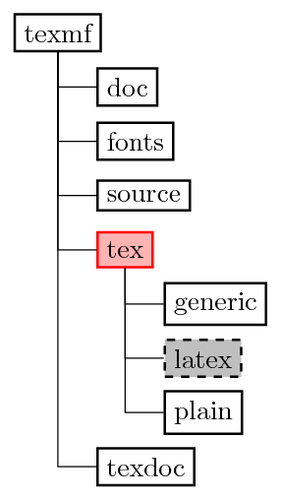
Edit and compile if you like:
% Author: Frantisek Burian
\documentclass{minimal}
\usepackage{tikz}
\usepackage[active,tightpage]{preview}
\PreviewEnvironment{tikzpicture}
\setlength\PreviewBorder{5pt}%
\usetikzlibrary{trees}
\begin{document}
\tikzstyle{every node}=[draw=black,thick,anchor=west]
\tikzstyle{selected}=[draw=red,fill=red!30]
\tikzstyle{optional}=[dashed,fill=gray!50]
\begin{tikzpicture}[%
grow via three points={one child at (0.5,-0.7) and
two children at (0.5,-0.7) and (0.5,-1.4)},
edge from parent path={(\tikzparentnode.south) |- (\tikzchildnode.west)}]
\node {texmf}
child { node {doc}}
child { node {fonts}}
child { node {source}}
child { node [selected] {tex}
child { node {generic}}
child { node [optional] {latex}}
child { node {plain}}
}
child [missing] {}
child [missing] {}
child [missing] {}
child { node {texdoc}};
\end{tikzpicture}
\end{document}Click to download: filesystem-tree.tex • filesystem-tree.pdf
Open in Overleaf: filesystem-tree.tex


